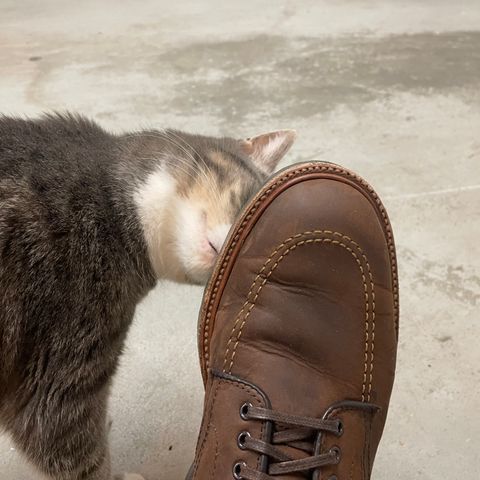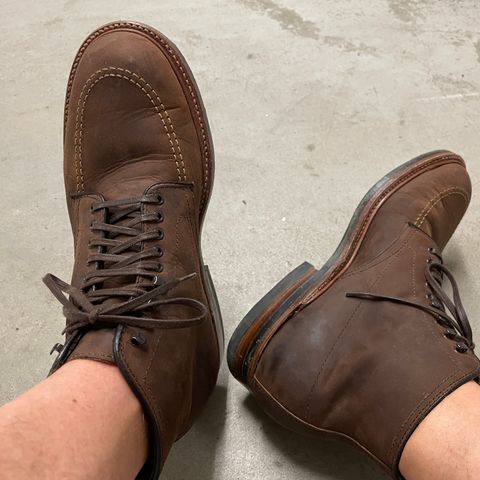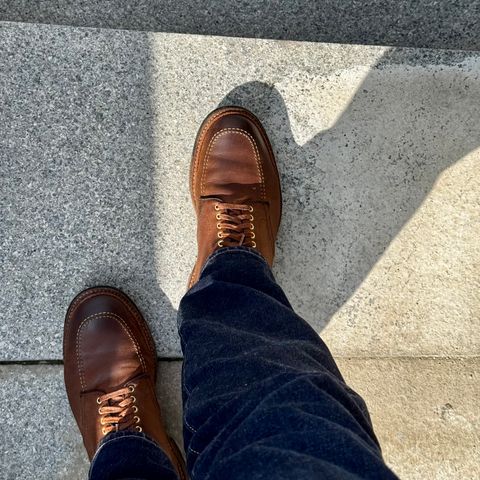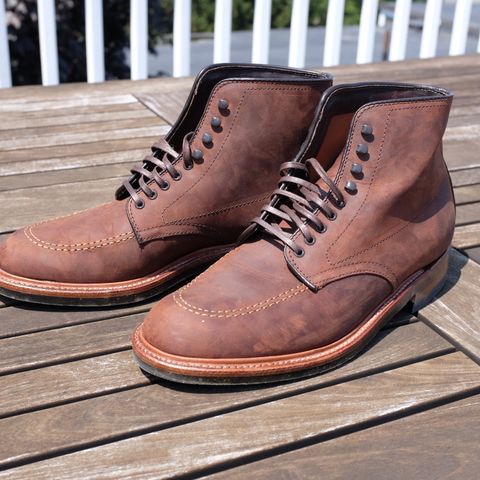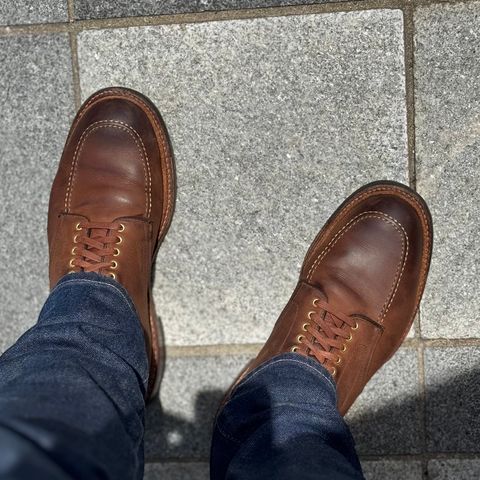About
Horween Smooth Chamois is a distinctive oil-tanned leather produced by Horween Leather Company that represents the modern evolution of traditional chamois leather manufacturing. Described as the "original oiled nubuck," this leather combines centuries-old oil tanning techniques with contemporary manufacturing processes to create a material characterized by exceptional oil content, natural patina development, and superior water absorption properties. The smooth chamois designation refers to the grain-side finish that provides a refined surface while maintaining the characteristic oily feel and flexible performance that defines the chamois category.
About
Horween Smooth Chamois is a distinctive oil-tanned leather produced by Horween Leather Company that represents the modern evolution of traditional chamois leather manufacturing. Described as the "original oiled nubuck," this leather combines centuries-old oil tanning techniques with contemporary manufacturing processes to create a material characterized by exceptional oil content, natural patina development, and superior water absorption properties. The smooth chamois designation refers to the grain-side finish that provides a refined surface while maintaining the characteristic oily feel and flexible performance that defines the chamois category.
Historical Background
Origins of Chamois Leather
The term "chamois" as applied to specially-prepared leather originated before 1709, initially referring to the prepared skin of goat-like animals, particularly the European antelope commonly called chamois. The technique was exclusively developed by the glovemaking industry in southwest France, where craftsmen discovered that tanning these skins in local cod oil from nearby Biarritz resulted in material with unprecedented absorbency and softness.
This traditional French approach established the foundational principles of oil tanning that would later influence leather production worldwide. The original chamois leather could absorb six times its weight in water while maintaining a luxurious, golden-soft finish that made it invaluable for specialized applications requiring both durability and absorbency.
Evolution to Modern Production
Oil tanning represents one of the oldest leather manufacturing methods still in commercial use, alongside vegetable and mineral tanning techniques. The traditional process involved fish oil or other fatty substances being mechanically pounded into dried hide until the oils replaced the natural moisture of the original skin. Hides were then hung in ovens where oxidized oil would permanently adhere to the skin fibers.
Horween's approach to chamois production maintains these essential oil tanning principles while incorporating modern quality control and consistency measures that ensure reliable product characteristics across production runs.
Manufacturing Process
Base Material Preparation
Horween Smooth Chamois begins with high-quality full-grain leather that undergoes initial processing to prepare the surface for oil absorption. The grain side is subtly sanded to create an attractive matte nubuck texture that provides optimal oil penetration while maintaining structural integrity. This surface preparation distinguishes smooth chamois from roughout variations by emphasizing the refined grain-side finish.
Oil Tanning Sequence
The defining characteristic of chamois production is the extensive oil treatment process. Horween employs a proprietary soaking procedure using a carefully balanced mixture of oils, greases, and waxes that penetrate throughout the leather structure. This oil infusion creates the smooth, oily surface and characteristic pull-up effect that defines quality chamois leather.
The oils used in modern chamois production maintain the oxidation principles of traditional cod oil tanning while utilizing contemporary formulations that provide consistent results. The oxidation process, which historically required 9-14 days, has been refined through the use of controlled environments and modern oxidizing agents to ensure thorough penetration and proper chemical bonding with the leather fibers.
Vegetable Re-tanning Integration
Horween's chamois production incorporates vegetable re-tanning elements that enhance the leather's natural characteristics. This vegetable component contributes to the intense oil content that creates the distinctive "scent" associated with quality chamois while enabling the refined patina development that occurs with age and use.
The combination of oil saturation and vegetable tanning influences results in leather with elastic flexibility and minimal maintenance requirements, allowing the material to perform effectively across a wide range of applications without frequent conditioning or special care.
Physical Characteristics
Texture and Feel
Horween Smooth Chamois exhibits a unique texture that is simultaneously soft and subtly velvety to the touch. The supple and flexible nature provides a distinctive tactile experience that differentiates it from conventional leather finishes. The grain side maintains the refined appearance of quality nubuck while the flesh side demonstrates the characteristic napped texture with a subtle gloss effect where oils show through the hide structure.
Pull-up Effect
One of the most distinctive characteristics of Horween Smooth Chamois is its pronounced pull-up effect. When the leather is stretched or flexed, the surface lightens noticeably, returning to its original hue when tension is released. This visual response to mechanical stress indicates proper oil saturation and demonstrates the leather's ability to maintain its appearance characteristics under normal use conditions.
The pull-up effect serves both aesthetic and practical purposes, creating visual interest during use while indicating the leather's flexibility and oil content. This characteristic is particularly valued in applications where the leather will experience regular flexing or stretching.
Oil Content and Absorption
The intensive oil treatment that defines chamois leather results in material with exceptional absorption capabilities inherited from traditional chamois manufacturing. While modern smooth chamois may not achieve the six-fold water absorption of historical cod oil-tanned versions, it maintains superior moisture management compared to conventional leather finishes.
The high oil content creates a natural barrier against moisture penetration while allowing the leather to breathe effectively. This balance provides practical advantages in footwear and leather goods applications where both water resistance and breathability are desired characteristics.
Color Development and Patina
Horween Smooth Chamois develops sophisticated patina characteristics over time, with the oil-rich surface responding to handling, light exposure, and environmental conditions. Areas subject to regular contact become glossier and typically darker, while protected areas maintain their original appearance, creating natural contrast that enhances the leather's visual appeal.
The patina development process is gradual and generally considered an improvement to the leather's appearance rather than degradation. The oil content ensures that aging occurs uniformly without the cracking or drying that can affect less thoroughly treated leathers.
Applications and Uses
Traditional Applications
Historically, oil-tanned chamois leather found primary application in glove manufacturing, where its combination of softness, flexibility, and durability made it ideal for work gloves requiring superior grip and comfort. These traditional applications established chamois leather's reputation for reliability in demanding environments.
The filtration and cleaning applications that historically utilized oil-tanned leather capitalized on the material's absorption characteristics and lint-free properties. These industrial applications demonstrated the practical advantages of proper oil tanning in specialized service environments.
Modern Footwear Applications
Contemporary Horween Smooth Chamois applications focus heavily on premium footwear manufacturing, where the leather's unique characteristics serve both functional and aesthetic purposes. Work boots utilizing chamois leather benefit from the material's natural flexibility and durability, while heritage and fashion footwear applications capitalize on the distinctive appearance and patina development.
The leather's compatibility with various construction methods and its ability to maintain performance characteristics under diverse conditions make it valuable for hiking boots, casual footwear, and specialty applications where traditional leather finishes may prove inadequate.
Emerging Applications
Recent developments in biomedical applications have recognized the beneficial properties of oil-tanned leathers, though these specialized uses remain limited compared to traditional leather goods and footwear applications. The material's natural characteristics continue to find new applications as understanding of oil tanning benefits expands.
Care and Maintenance
Horween Smooth Chamois requires minimal maintenance compared to conventional leather finishes, largely due to its intensive oil treatment during manufacturing. The high oil content provides ongoing protection against moisture and environmental stress, reducing the frequency of conditioning treatments typically required for other leather types.
When maintenance is required, quality leather conditioners that are compatible with oil-tanned leather should be used sparingly to avoid over-saturating the already oil-rich material. The leather responds well to gentle brushing that helps maintain the nubuck texture while distributing oils evenly across the surface.
Market Position
Horween Smooth Chamois occupies a premium position in the specialty leather market, reflecting both the labor-intensive manufacturing process and the distinctive performance characteristics that result from proper oil tanning. The material's reputation for quality and durability supports its positioning in high-end leather goods and footwear applications where consumers appreciate traditional craftsmanship and superior materials.
References
"Horween Chamois Leather". The Tannery Row. Retrieved September 5, 2025.
"Horween Chamois Leather". A & A Crack & Sons. Retrieved September 5, 2025.
"An Eco-Friendlier Leather? The Fascinating History of Traditional Leather Tanning Techniques". No Momento. Retrieved September 5, 2025.
"Oil tanning". Britannica. Retrieved September 5, 2025.
"Chamois". Hutchings & Harding. Retrieved September 5, 2025.
"Recent trends in oil tanning and its applications - A way forward towards cleaner approach in chamois leather making". ScienceDirect. Retrieved September 5, 2025.
